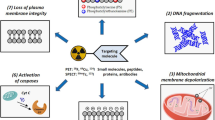Abstract
Objective
A recombinant annexin A5 with the N-terminal extension of six histidine residues was labeled with 99mTc(I)-tricarbonyl ion to produce the 99mTc-labeled annexin A5, referred to 99mTc(I)-his6-annexin A5. We have explored the agent as an effective imaging probe for in vivo detecting the apoptosis of internal tissue subjected with high radiation doses in a γ-irradiated mouse model.
Methods
[99mTc(CO)3(OH2)3]+ was prepared and taken to directly label his6-annexin A5. The radiochemical purity of 99mTc(I)-his6-annexin A5 after size-exclusion separation was measured by HPLC. The binding affinity of 99mTc(I)-his6-annexin A5 to apoptotic cells was assessed using 20 Gy-irradiated Jurkat T cells. The effectiveness of 99mTc(I)-his6-annexin A5 as an imaging probe to detect the internal tissue apoptosis was assessed by biodistribution study and nanoSPECT/CT using the animal model of C57BL/6J mice conducted with 10 Gy γ irradiation.
Results
The radiochemical purity of 99mTc(I)-his6-annexin A5 could attain ≥95%. The binding affinity of 99mTc(I)-his6-annexin A5 to the 20 Gy-irradiated Jurkat cells was found to be ca. 20-fold higher than that to the sham-irradiated cells. In the animal imaging study, the splenic uptake of 99mTc(I)-his6-annexin A5 for the 10 Gy-irradiated mice showed from ca. 3-fold to 5-fold higher than those of the sham-irradiated mice from 45 to 165 min postinjection. The corresponding intestinal uptake showed from ca. 2-fold to 3-fold higher during the same period of time postinjection. The biodistribution study demonstrated the organ uptakes comparable with the imaging results. The apoptotic extents of the spleen and the intestine from the SPECT/CT imaging were correlated with an immunohistochemical staining assay for caspase 3 active form fragment.
Conclusion
This work is the first study to demonstrate that 99mTc(I)-his6-annexin A5 is a potential clinical imaging agent for detecting radiation-induced tissue apoptosis in an animal model.





Similar content being viewed by others
References
Tait JF, Gibson D, Fujikawa K. Phospholipid binding properties of human placental anticoagulant protein-I, a member of the lipocortin family. J Biol Chem. 1989;264:7944–9.
Zhang G, Gurtu V, Kain SR, Yan G. Early detection of apoptosis using a fluorescent conjugate of annexin V. Biotechniques. 1997;23:525–31.
Chen YL, Wu CC, Lin YC, Pan YH, Lee TW, Lo JM. 99mTc(I) tricarbonyl labeled histidine-tagged annexin V for apoptosis imaging. IFMBE Proc. 2009;23:1393–6.
Lahorte C, Slegers G, Philippé J, Van de Wiele C, Dierckx RA. Synthesis and in vitro evaluation of 123I-labelled human recombinant annexin V. Biomol Eng. 2001;17:51–3.
Ke S, Wen X, Wu QP, Wallace S, Charnsangavej C, Stachowiak AM, et al. Imaging taxane-induced tumor apoptosis using PEGylated, 111In-labeled annexin V. J Nucl Med. 2004;45:108–15.
Ito M, Tomiyosh K, Takahashi N. Development of a new ligand, 11C-labeled annexin V, for PET imaging of apoptosis. J Nucl Med. 2002;43:362P. (abstract).
Zijlstra S, Gunawan J, Burchert W. Synthesis and evaluation of a 18F-labelled recombinant annexin-V derivative, for identification and quantification of apoptotic cells with PET. Appl Radiat Isot. 2003;58:201–7.
Avila-Rodriguez MA, DeJesus OT, Converse AK, Hampel JA, Nickles J. High specific activity 64Cu for the radiolabeling of DOTA-conjugates and bis(thiosemicarbazone) complexes. J Label Comp Radiopharm. 2007;50:S44. (abstract).
Smith-Jones PM, Afroze A, Zanzonico P, Tait J, Larson SM, Strauss HW. 68Ga labeling of annexin V: comparison to 99mTc-annexin V and 67Ga-annexin V. J Nucl Med. 2003;44:49–50. (abstract).
Glaser M, Collingridge DR, Aboagye EO, Bouchier-Hayes L, Hutchinson OC, Martin SJ, et al. Iodine-124 labelled annexin-V as a potential radiotracer to study apoptosis using positron emission tomography. Appl Radiat Isot. 2003;58:55–62.
Russell J, O’Donoghue JA, Finn R, Koziorowski J, Ruan S, Humm JL, et al. Iodination of annexin V for imaging apoptosis. J Nucl Med. 2002;43:671–7.
Kemerink GJ, Liu X, Kieffer D, Ceyssens S, Mortelmans L, Verbruggen AM, et al. Safety, biodistribution, and dosimetry of 99mTc-HYNIC-annexin V, a novel human recombinant annexin V for human application. J Nucl Med. 2003;44:947–52.
Mochizuki T, Kuge Y, Zhao S, Tsukamoto E, Hosokawa M, Strauss HW, et al. Detection of apoptotic tumor response in vivo after a single dose of chemotherapy with 99mTc-annexin V. J Nucl Med. 2003;44:92–7.
Blankenberg FG, Tait JF, Strauss HW. Apoptotic cell death: its implications for imaging in the next millennium. Eur J Nucl Med. 2000;27:359–67.
Subbarayan M, Hafeli UO, Feyes DK, Unnithan J, Emancipator SN, Mukhtar H. A simplified method for preparation of 99mTc-annexin V and its biologic evaluation for in vivo imaging of apoptosis after photodynamic therapy. J Nucl Med. 2003;44:650–6.
Tait JF, Smith C, Blankenberg FG. Structural requirements for in vivo detection of cell death with 99mTc-annexin V. J Nucl Med. 2005;46:807–15.
Verheij M. Clinical biomarkers and imaging for radiotherapy-induced cell death. Cancer Metastasis Rev. 2008;27:471–80.
Tait JF, Smith C, Gibson DF. Development of annexin V mutants suitable for labeling with Tc(I)-carbonyl complex. Bioconjugate Chem. 2002;13:1119–22.
Vangestel C, Peeters M, Oltenfreiter R, D’Asseler Y, Staelens S, Steenkiste MV, et al. In vitro and in vivo evaluation of [99mTc]-labeled tricarbonyl his-annexin A5 as an imaging agent for the detection of phosphatidyl serin-expressing cells. Nucl Med Biol. 2010;37:965–75.
Paris F, Fuks Z, Kang A, Capodieci P, Juan G, Ehleiter D, et al. Endothelial apoptosis as the primary lesion initiating intestinal radiation damage in mice. Science. 2001;293:293–7.
Liu WC, Wang SC, Tsai ML, Chen MC, Wang YC, Hong JH, et al. Protection against radiation-induced bone marrow and intestinal injuries by Cordyceps sinensis, a Chinese herbal medicine. Radiat Res. 2006;166:900–7.
Acknowledgments
This study was financially supported by Chang-Gung/Tsing-Hua Collaborative Research Project. We would like to express our sincere appreciation to Professor Shiaw-Pyng Wey of Department of Medical Imaging and Radiological Sciences, Chang Gung University, Linkou, Taogyuan, Taiwan for his help in preparation of 99mTc-labeled annexin A5. The advice to the paper from Professor Chien-Wen Chang of Department of Biomedical Engineering and Environmental Sciences, National Tsing Hua University, Hsinchu, Taiwan is very much appreciated. We thank Ms. Yi-Ching Lin for the technical assistance to the study.
Author information
Authors and Affiliations
Corresponding author
Rights and permissions
About this article
Cite this article
Lin, KJ., Wu, CC., Pan, YH. et al. In vivo imaging of radiation-induced tissue apoptosis by 99mTc(I)-his6-annexin A5. Ann Nucl Med 26, 272–280 (2012). https://doi.org/10.1007/s12149-012-0571-x
Received:
Accepted:
Published:
Issue Date:
DOI: https://doi.org/10.1007/s12149-012-0571-x




